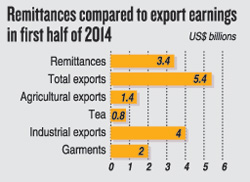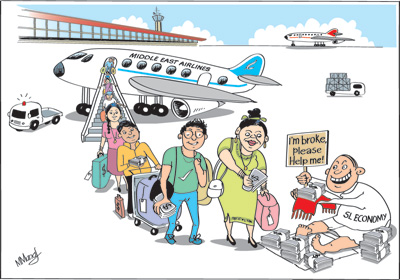Columns
A remittance dependent import-export economy
View(s): The Sri Lankan economy is increasingly becoming a remittance dependent import-export economy. In the first half of this year remittances amounted to US$ 3.36 billion — a 10.6 per cent increase from that of the first half of last year. These remittances in the first half of the year almost wiped out the trade deficit, financed the entirety of the large oil import expenditure. Remittances are the main reason for expecting a significant balance of payments surplus this year despite a likely trade deficit of about US$ 7 billion.
The Sri Lankan economy is increasingly becoming a remittance dependent import-export economy. In the first half of this year remittances amounted to US$ 3.36 billion — a 10.6 per cent increase from that of the first half of last year. These remittances in the first half of the year almost wiped out the trade deficit, financed the entirety of the large oil import expenditure. Remittances are the main reason for expecting a significant balance of payments surplus this year despite a likely trade deficit of about US$ 7 billion.
Paramount importance
Remittances were 9.5 per cent of GDP in 2013. In the first half of this year remittances were as much as 61 per cent of export earnings. Garments, the largest export of the country, earned only 72 per cent as much as remittances; booming tourism earned only 31 per cent as much as remittances and tea exports were less than one fourth (23.7 per cent) that of workers’ remittances.
The total inflows of capital to the Government in the form of foreign investments in Treasury Bills and bonds, sovereign bonds and long term loans, all of which are repayable, were only 2 per cent more than remittances in the first half of this year. Foreign direct investments were negligible compared to remittances. In the last decade remittances were much larger than official development assistance (ODA), foreign direct investment (FDI) or aid and even all three taken together.
 Increasing remittances
Increasing remittances
Workers’ remittances have increased progressively over the years and especially since 2010. In the last five years a high proportion of the large trade deficits were offset by remittances. In 2009 the trade deficit of US$ 3.12 billion was completely offset by remittances of US$ 3.33 billion. In 2010 remittances increased to US$ 4.16 billion, while in 2011 remittances increased to US$ 5.15 billion and offset around 70 per cent of the trade deficits of these years.
Although remittances increased to nearly US$ 6 billion in 2012, the massive increase in the trade deficit to US$ 9.6 billion resulted in remittances offsetting only 63 per cent of the trade deficit. In 2013 remittances of US$ 6.4 billion offset as much as 84 per cent of the deficit. Workers’ remittances are therefore a huge contributor to the balance of payments and the economy.
Remittances from many countries
It is generically believed that remittances are from workers in the Middle East. In fact, remittances are from a wide range of countries. Remittances from migrant workers from the Middle East have been highlighted as these constituted 55 to 60 per cent of total remittances. In 2013 they accounted for 55.6 per cent of total remittances.
Remittances from other regions are not inconsequential. Remittances from Italy, South Korea, Malaysia and Singapore are noteworthy. There have been increasing inflows of remittances from European countries and North America. The remittances from North America, Europe, Australia and New Zealand were nearly 28 per cent. These remittances are most probably from professionals for the upkeep of family members, purchase of land and other investments such as holiday homes and apartments.
Benefits
Remittances have provided significant support to the balance of payments, increased the investment rate in the country and helped to bring about some macro-economic stability. At household level remittances have mitigated poverty, improved household’s ability to endure external shocks, provided credit for household enterprises and increased investment in health, education and housing, especially in rural areas.
 Employment and unemployment
Employment and unemployment
The country has achieved a low level of unemployment due to lower inflows to the labour force as a result of the declining population growth and out-migration of workers. A significant proportion of the labour force working abroad has contributed to reducing the unemployment rate. It has also increased wages of skilled and unskilled workers in the country.
Although migration has reduced unemployment, it has created a labour shortage, exposed the country to shocks experienced in destination countries and resulted in a scarcity of skilled workers.
Social costs
Despite the many benefits of remittances to the economy, one must be mindful of social costs of migration. The migration of parents can leave families of young children with inadequate guidance.
The additional burden of household responsibilities on a single parent or relative can lead to higher school absenteeism, school drop-outs, poor nutrition and health care of especially younger children. The disruption of the family, child abuse, school dropouts, family break-ups, neglect of children and ageing parents and drug addiction are a result of family separation and families with no mothers to look after the welfare of the children.
The negative effects of migration include the disintegration of families, violations of the rights of the workers and a lack of interest on policies that create jobs domestically.
There is lack of protection and welfare for workers and social and psychological costs associated with migration that has been of special concern to housemaids and low skilled migrants with little education.
There are numerous instances where these workers have been sexually and physically abused and not properly paid for their services.
Summing up
Remittances from migrant workers and expatriates have an importance far beyond the support to the balance of payments. However there are both benefits and adverse impacts of outmigration. The main positive impacts are that remittances strengthen the balance of payments and contribute towards increasing incomes, reduction of unemployment and poverty and contribute to the improvement of living conditions and livelihoods.
No doubt remittances are one of the ways by which poverty has been alleviated and incomes enhanced of the poor, especially those in rural areas. The living standards of the poor have improved due to the higher incomes, increasing expenditure on basic consumption, housing and education, and enabling the startup of small business enterprises. Unemployment in the country has been reduced by migration but availability of skilled labour has decreased and wages have increased.
Despite these benefits migration of workers are not without the social costs discussed, especially at the family level.

